
Wine Culture and Information since 2002 - Volume 22
 Wine Culture and Information since 2002 - Volume 22 |
|
Issue 204, March 2021 |
Contents |
|
|
Wine is Harmful to Your Health. Maybe. |
|
These are difficult times for wine. The crisis caused by the Covid-19 pandemic seems to be not enough, now there is also the suspicion wine can be harmful to your health and even in a very serious way. Nevertheless, in Italy we have always been used to hearing that wine makes good blood and may have positive effects on health. For years, we have continuously heard authoritative figures of the world of medicine and science asserting wine can also have positive effects on people's health. Let's be clear: the abuse of wine consumption – and this has always been known by everyone – is certainly not healthy at all, after all, even the excessive consumption of the harmless water has consequences on health, so researchers tell us, as it may cause a kind of addiction. Of course, the consequences are very different and with a very different impact, perhaps the healthy and wise principle of common sense is always very useful, also by remembering that, as Paracelsus notoriously suggested, “it is the dose that makes the poison”. In the past few weeks, the world of wine has been “alarmed” in consequence of a plan proposed by the European Commission called “Europe's Beating Cancer Plan” and which will be promoted – it seems – in the course of 2021 with the “HealthyLifestyle4All” campaign. This document has caused some concern in the world of wine – Italian, in particular – assuming that, in the measures proposed by the document, wine was also implicitly affected. This plan, in fact, explicitly refers to the need of contrasting the excessive consumption of alcohol, considered one of the causes that could favor the development of this pathology. The plan also explicitly refers to alcoholic beverages – and wine is, undeniably, an alcoholic beverage – however without mentioning the word “wine” at all. The plan, due to these references, was however enough to alarm the world of wine. Let's make a necessary premise: any campaign in favor of disease prevention – any disease – can only be welcomed favorably, since the health of individuals – and therefore of the entire community, in this case the European Union – is an essential condition for the well-being of all. Including the productive, economic and social ones. That alcohol, or rather alcohol abuse, is one of the causes that could favor the development of serious diseases, and not only cancer, is something that everyone has known for a very long time. The same is also known for tobacco and for a long list of substances, also intended for human and animal nutrition. The prevention plan proposed by the European Commission, in fact, also takes into consideration these substances, therefore not only alcohol and, in this regard, the plan particularly suggests “the reduction of the harmful consumption of alcohol” aiming to a relative reduction of at least 10% of the harmful use of alcohol by 2025. Among the measures proposed in this plan, There is also the obligation to write in the label of alcoholic beverages the list of ingredients and the nutritional declaration by 2022 in addition to the health warnings to be written by 2023. In other words, the label should inform consumers on the possible risks deriving from the consumption of alcoholic beverages, exactly as it is already reported, for example, in the packs of cigarettes and tobacco. This last part has caused a certain alarm in the world of wine, that is the possibility of indicating the composition on the label in addition to the warnings relating to health risks, well known for years to all consumers of cigarette packs. In short, the fear of seeing warnings such as “it is harmful to your health” written in wine bottles could be likely to happen in case this plan is approved. Likewise, this could also be true for any alcoholic beverage, as in this plan are generically mentioned all these types of products. Following the complaints of producers and trade associations related to wine, the vice president of the European Commission Margaritis Schinas pointed out that `«certainly the European Union will not ban wine, and we will not label wine as being something that is toxic as it is part of who we are and of our way of life». This declaration was then followed by the words of the Commissioner for health Stella Kyriakides, confirming that «the European Commission will propose mandatory labeling of ingredients and nutrient content, along with health warnings on alcoholic beverages. Initiatives that will be based on the experiences already made in order to give consumers more possibilities to choose with greater awareness». Having said this, and assuming that words are followed by concrete and coherent facts, these are positions that can be supported. In case, indeed, there is a risk, it is always better to be informed in advance and then, if necessary, make a choice with the awareness of the possible consequences. Regardless of whether it is wine or not. In my opinion, the goal of this plan in contrasting the abuse of alcoholic beverages must necessarily be considered, especially in the younger population and which, obviously, is decidedly more fragile in regard of these issues. The plan, in fact, explicitly refers to alcoholic beverages, so it is not exclusively about wine but all of them in a general sense. The abuse of alcoholic beverages – whether it is wine or not – is certainly something that must be contrasted, especially in cultural term, particularly in the younger population. I think we all agree that drinking a glass of wine is not exactly like drinking an equal amount – so to speak – of brandy or any other spirit. With this, of course, I have no intention of denigrating either brandy or spirits in a general sense, as they are types of alcoholic beverages I appreciate, support and consume. But, of course, as Paracelsus said “it is the dose that makes the poison” and we know very well that, technically speaking, ethyl alcohol is a toxic substance. Of course, if consumed in large quantities and by abusing of it. It is the dose that makes the poison, in fact. I don't deny it: the idea of seeing warnings in wine labels such as “it seriously harms your health” is something disturbing me as it would be like arguing that our millenary culture – which has undeniably developed also on viticulture, production and consumption of wine – is, in some respects, equally harmful to health. In particular for the fact I believe I know the value of wine, and not only in cultural and identity terms, not only for Italy but for many other European countries, and the value, including the economic one, it represents for all of us. And it is because I know the value of wine and alcoholic beverages, I believe it is equally right to support and encourage conscious consumption without excessive abuse because this, not least, undermines the dignity and meaning of wine and its culture. Therefore, any plan aimed at preventing the abuse of alcoholic beverages are welcome, for which the effectiveness of the results – I have always been convinced of this – is fundamentally based on culture and the education of awareness to “responsible drinking”. And as I usually end the episodes of DiWineTaste podcast, also in this occasion, I am wishing you all to “have good wine, in moderation, provided it is always a quality wine”. Antonello Biancalana
|
||||
Contrasts of Ormeasco di Pornassio Superiore and Rosso Piceno Superiore |
|
Two red wines from Liguria and Marches, produced in two of the most important wine-growing areas of their respective regions, compared in the glasses of this month's tasting by contrast The vastness of the Italian ampelographic heritage is notoriously the richest among the wine-growing countries in the world. This richness has been underlined several times in the pages of our monthly magazine and is undeniably one – but not the only one – of the factors making Italy a unique, special and particular country for wine, last but not least, prove its indisputable viticultural and enological vocation. Italy's relationship with vine and wine has its origins in the dawn of civilization and we know that, in these lands, the vine has been present since time immemorial. The ancient Greeks knew this very well and, despite they introduced many of their varieties in Italy, when they arrived in what was known in ancient times as Magna Graecia, in the southern part, the vine was already present and thriving in these lands. It is no coincidence, evidently, that they called part of this territory Enotria, and – although it derives from the name of the Greek mythological figure Enotro – the term notoriously had the meaning of land of wine. Many of the native Italian varieties have also spread to other regions of the country, not least, even traveling far beyond national borders. This is what happened – in fact – to the grapes used for the production of the wines of this month's tasting by contrast. The first one, Ormeasco di Pornassio Superiore, is produced with Dolcetto grape which, having arrived in Liguria from the nearby Piedmont, here takes the name of Ormeasco. Rosso Piceno Superiore – the second wine of our tasting by contrast – is produced with two of the best known and most widespread varieties of the Italian ampelographic scenario: Montepulciano and Sangiovese. Also in this case they are two native Italian varieties, widely spread in central Italy and which are used in many wines in the regions of this area, including Marches. Montepulciano originates in the territory on the border between the Marches and Abruzzo, therefore a full-fledged variety of Piceno; Sangiovese was certainly introduced by settlers after having crossed the neighboring regions. In both cases, the varieties making up these two wines have proven a perfect adaptation in their respective territories, giving proof of this with wines of absolute value and quality.
|
|
Liguria, a suggestive region with enchanting landscapes divided between the sea and the mountains, is a land having a magnificent enological vocation and from which wines with enormous personality are produced. This region is in fact rich in white and red varieties, often present within its territory only, and with which different styles of wines are produced, from whites and reds, to sparkling wines and sweet passito. In this regard, Ormeasco di Pornassio perfectly represents the enological diversity of Liguria as it includes – in addition to the “Superiore” style that we will examine in our tasting – also the styles Sciac-Tra, with a characteristic pink color, passito and liquoroso passito. In this regard, it should be noted that Ormeasco di Pornassio Sciac-Tra should not be confused with Cinque Terre Sciacchetrà as they are completely different styles, produced in different territories and with different grapes. Ormeasco di Pornassio Sciac-Tra is in fact a rosé wine, Cinque Terre Sciacchetrà is a sweet wine made from dried grapes, specifically Vermentino, Bosco and Albarola. Ormeasco di Pornassio is recognized as a Denominazione d'Origine Controllata area (Denomination of Controlled Origin, DOC) and takes its name from both the grape and the area where this wine is produced, in the province of Imperia. Ormeasco is a grape variety belonging to family of Dolcetto, a grape native to Piedmont and widely spread in this region. The bond of this territory with the Ormeasco grape is documented as early as 1300s, in particular, an edict promulgated by the Marquis of Clavesana in 1303 – governor of the lands of Pornassio and Pieve di Teco – who imposed, under penalty of beheading, that in his fief only this grape was allowed for cultivation. It is believed the introduction of Ormeasco in these lands was done by the Saracens, spreading it in the territory near Ormea, a village in the Ligurian Alps in the province of Cuneo, a place from which it is believed it took the name Ormeasco. Ormeasco di Pornassio Superiore – which we will examine in the tasting of this month – is characterized by the higher alcoholic percentage and requires a period of aging in cask for at least 4 months. As for the composition, it should be noted that the production disciplinary provides for the use of Ormeasco (Dolcetto) grape for a minimum of 95%, however the main tendency of producers is to use this variety alone in their wines.
|
||||
|
Marches – a beautiful region in central Italy – like Liguria, is a land of interesting viticultural and enological richness, in fact some of the most famous and renowned wines of Italian enology are produced in this land. Among these, we certainly have Rosso Piceno, a wine produced in the largest and most spread Denominazione d'Origine Controllata area Marches. The territory in which Rosso Piceno is produced is spread, in fact, in the provinces of Ancona, Ascoli Piceno, Fermo and Macerata. In this regard, it should be noted Rosso Piceno Superiore – that is the wine we are considering in our tasting by contrast – actually corresponds to a specific sub-area of the appellation and its production is only allowed in 13 municipalities in the eastern part of the province of Ascoli Piceno. Furthermore, compared to the wines of the rest of the appellation, Rosso Piceno Superiore provides for a longer aging period before being released in the market. The wines belonging to the Rosso Piceno denomination – including the Superiore style – are produced with Montepulciano grapes, from 35% to 85%, and Sangiovese, from 15% to 50%. It is also allowed the use of other red berried grapes cultivated in the Marches and for a maximum of 15%. As far as the composition of Rosso Piceno is concerned, it should be noted most of producers tend to use Montepulciano and Sangiovese only, often using the first of these for the maximum percentage allowed by the production disciplinary. However, the presence of Sangiovese contributes decisively to the character of Rosso Piceno, giving it a pleasant crispness, typical of this variety. Finally, it should be noted the bond of the Piceno territory with the vine and wine has very ancient and historical origins, widely proven by authors of the past, including Cato and Polybius. At those times this area was already known for the abundant production of wines – a characteristic that it has preserved for centuries – and they were exported and marketed even in the distant territory of Gaul.
|
We are about to choose the two wines we will pour into the glasses of this month's tasting by contrast. Of the two wines, the easiest to find is Rosso Piceno Superiore. Ormeasco di Pornassio Superiore – in fact – is produced in a much smaller territory than that of Rosso Piceno, with a lower production than the wine from Marches, therefore more difficult to find on the market. As for Ormeasco di Pornassio Superiore, we will choose a bottle produced with 100% Dolcetto and aged in cask, in any case not more than three years from the harvest. As for choosing Rosso Piceno Superiore we will follow the same criteria, therefore aged in cask and not more than three years from harvesting. Talking about composition, we will choose a wine produced with Montepulciano for at least 60% and the remainder made up exclusively of Sangiovese. The two wines are tasted at a temperature of 18 °C (65 °F) and poured into tasting glasses. We can now begin the tasting by contrast of Ormeasco di Pornassio Superiore and Rosso Piceno Superiore, taking into consideration – as usual – the appearance of the wine. Let's start this first phase of the tasting by evaluating the glass of the Ligurian wine. Let's tilt the glass over a white surface – for example a sheet of paper – and observe the base in order to evaluate the color of the wine. Ormeasco di Pornassio Superiore shows an intense and brilliant ruby red color, with a moderate transparency, however not high. Let's now observe the wine towards the opening of the glass, in order to appreciate the nuance. In the Ligurian wine we can see a ruby red color, sometimes with purple red hues. Let's now pass to the evaluation of the appearance of Rosso Piceno Superiore, tilting the glass – also in this case – over the white surface. Let's observe the base of the glass: the wine from Marches has an intense and brilliant ruby red color, also in this case with moderate transparency. The nuance of Rosso Piceno Superiore – observed towards the opening of the glass – reveals a ruby red hue, sometimes tending to garnet. The aromas perceived in the glasses of Ormeasco di Pornassio Superiore and Rosso Piceno Superiore are decidedly distant. First of all, in the Ligurian wine we find the expression of Ormeasco grape only – that is, Dolcetto – while in the one from the Marches region the olfactory profile is made up of the combined qualities of both Montepulciano and Sangiovese. Ormeasco di Pornassio expresses to the nose aromas of cherry, blackberry, plum, sometimes black currant, with evident hints of violet. As for the superiore style, the aging gives the wine tertiary sensations and which can also recall certain spices such as black pepper. In this wine we can also perceive aromas of red fruits, including raspberry and pomegranate. The profile of Rosso Piceno Superiore is quite different, characterized by dark fruits, in particular black cherry, plum, blueberry and blackberry, as well as pleasant sensations of flowers, in particular violet and rose. Also in this case, the aging in wood gives the wine tertiary and balsamic sensations, in particular menthol. Let's resume our tasting by contrast and proceed with the evaluation of the olfactory profiles of Ormeasco di Pornassio Superiore and Rosso Piceno Superiore, starting – just like the previous phase – with the examination of the Ligurian wine. Let's hold the glass in vertical position and, without swirling, let's proceed with the first smell in order to evaluate the opening of the wine, that is the primary and identifying aromas, a characteristic also known as “first nose”. We can perceive from the glass intense aromas of cherry, blackberry and plum as well as the floral aroma of violet. Let's now proceed with the swirling of the glass – operation favoring the oxygenation of the wine, therefore the development of its aromas – and let's do the second smell. The profile of Ormeasco di Pornassio Superiore is completed with black currant, rose, raspberry and pomegranate, sometimes followed by the spicy character reminiscent of black pepper. Let's now pass to the evaluation of the opening of Rosso Piceno Superiore and, by holding the glass in vertical position, let's proceed with the first smell. The wine from Marches opens on the nose with aromas of black cherry, plum and blueberry, in addition to the floral sensation in which we can perceive violet. After having swirled the glass, Rosso Piceno Superiore is completed with blackberry, raspberry and an elegant hint of rose. In both wines the tertiary characteristics given by the aging in wood are evident, in particular vanilla. Let's now move on to the third phase of this month's sensorial tasting by contrast, proceeding with the examination of the gustatory profiles. The first wine we will examine, just like in the previous phases, is Ormeasco di Pornassio Superiore, hence – after having taken a sip – let's evaluate its attack, that is the identifying gustatory sensations. The Ligurian wine is characterized by an attack of moderate astringency in which is perceived a pleasing crispness, sensations that are well balanced by the effect of alcohol and moderate roundness. In the mouth is perceived a good structure as well as pleasing flavors of cherry, blackberry and plum, thus confirming the good correspondence to the nose. Let's move on to the evaluation of the attack of the second wine and take a sip of Rosso Piceno Superiore. The wine from Marches is characterized in the mouth with a more intense sensation of astringency than the Ligurian one and, also in this case, is perceived a pleasing crispness, mainly contributed by Sangiovese. Balance is obtained with the effect of both alcohol and roundness, the latter also accentuated by the aging in cask. The structure of Rosso Piceno Superiore is – in general terms – more robust than Ormeasco di Pornassio Superiore. In the mouth, finally, are perceived the flavors of plum, black cherry and blueberry, confirming, also for this wine, the good correspondence to the nose. We conclude this month's tasting by contrast with the evaluation of the final sensations the two wines leave in the mouth after swallowing, in particular the taste-olfactory persistence. The finish of Ormeasco di Pornassio Superiore is persistent, leaving in the mouth pleasing flavors of cherry, blackberry and plum, as well as the characteristic slightly bitter sensation sometimes reminiscent of almond. We also continue to perceive a pleasing sensation of crispness and moderate astringency, as well as a good structure. The finish of Rosso Piceno Superiore is equally persistent and in the mouth are clearly perceived the flavors of black cherry, plum and blueberry, often blackberry and raspberry as well. Compared to the Ligurian wine, here the final sensation of crispness is weaker, however those of astringency and structure are more evident. Ormeasco di Pornassio Superiore and Rosso Piceno Superiore confirm their distant diversity, under every aspect of the sensorial evaluation. The further examination of both wines, especially of the olfactory profiles, confirms the respective differences including their undeniable enological quality.
|
||||||||
Wines of the Month |
|
|
|
Score legend Prices are to be considered as indicative. Prices may vary according to the country or the shop where wines are bought |
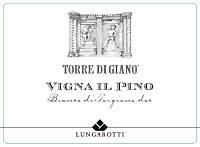
|
|
Torgiano Bianco Torre di Giano Vigna il Pino 2017 |
|
| Lungarotti (Umbria, Italy) | |
 Vermentino, Grechetto, Trebbiano Toscano Vermentino, Grechetto, Trebbiano Toscano | |
| Price: € 18.00 | Score: |
 Intense straw yellow and nuances of straw yellow, very transparent. Intense straw yellow and nuances of straw yellow, very transparent. Intense, clean, pleasing, refined and elegant, starts with hints of apple,
plum and grapefruit followed by aromas of papaya, hawthorn, broom, pear, medlar,
butter, hazelnut, thyme, vanilla and mineral. Intense, clean, pleasing, refined and elegant, starts with hints of apple,
plum and grapefruit followed by aromas of papaya, hawthorn, broom, pear, medlar,
butter, hazelnut, thyme, vanilla and mineral.
 Crisp attack and however balanced by alcohol, good body, intense flavors,
pleasing roundness. Crisp attack and however balanced by alcohol, good body, intense flavors,
pleasing roundness.
 Persistent finish with flavors of apple, papaya and grapefruit. Persistent finish with flavors of apple, papaya and grapefruit. 6 months in barrique, 3 months in steel tanks. 6 months in barrique, 3 months in steel tanks. |
|
 Stuffed pasta with mushrooms, Roasted fish, Roasted white meat, Mushroom soups Stuffed pasta with mushrooms, Roasted fish, Roasted white meat, Mushroom soups |
|
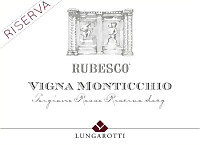
|
|
Torgiano Rosso Riserva Rubesco Vigna Monticchio 2015 |
|
| Lungarotti (Umbria, Italy) | |
 Sangiovese Sangiovese | |
| Price: € 35.00 | Score: |
 Intense ruby red and nuances of garnet red, little transparency. Intense ruby red and nuances of garnet red, little transparency. Intense, clean, pleasing, refined and elegant, starts with hints of
plum, black cherry and dried violet followed by aromas of blueberry,
raspberry, strawberry, blackberry, cinnamon, cocoa, tobacco, leather,
licorice, mace, vanilla and menthol. Intense, clean, pleasing, refined and elegant, starts with hints of
plum, black cherry and dried violet followed by aromas of blueberry,
raspberry, strawberry, blackberry, cinnamon, cocoa, tobacco, leather,
licorice, mace, vanilla and menthol.
 Properly tannic attack and however balanced by alcohol, full body,
intense flavors, pleasing crispness. Properly tannic attack and however balanced by alcohol, full body,
intense flavors, pleasing crispness.
 Very persistent finish with long flavors of plum, black cherry and
blueberry. Very persistent finish with long flavors of plum, black cherry and
blueberry.
 12 months in cask and barrique, 3 years in bottle. 12 months in cask and barrique, 3 years in bottle. |
|
 Game, Roasted meat, Braised and stewed meat with mushrooms, Hard cheese Game, Roasted meat, Braised and stewed meat with mushrooms, Hard cheese |
|
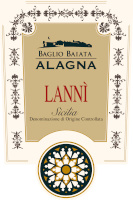
|
|
Sicilia Rosso Lannì 2017 |
|
| Alagna (Sicily, Italy) | |
 Nero d'Avola, Merlot, Syrah Nero d'Avola, Merlot, Syrah | |
| Price: € 11.50 | Score: |
 Intense ruby red and nuances of garnet red, little transparency. Intense ruby red and nuances of garnet red, little transparency. Intense, clean, pleasing and refined, starts with hints of blackberry,
black cherry and plum followed by aromas of dried violet, tobacco, carob,
dried fig and vanilla. Intense, clean, pleasing and refined, starts with hints of blackberry,
black cherry and plum followed by aromas of dried violet, tobacco, carob,
dried fig and vanilla.
 Properly tannic attack and however balanced by alcohol, good body,
intense flavors, pleasing crispness. Properly tannic attack and however balanced by alcohol, good body,
intense flavors, pleasing crispness.
 Persistent finish with flavors of blackberry, plum and black cherry. Persistent finish with flavors of blackberry, plum and black cherry. Aged in casks used for the production of fortified wines. Aged in casks used for the production of fortified wines. |
|
 Roasted meat, Stewed meat with mushrooms, Hard cheese Roasted meat, Stewed meat with mushrooms, Hard cheese |
|
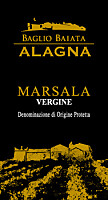
|
|
Marsala Vergine Baglio Baiata |
|
| Alagna (Sicily, Italy) | |
 Grillo, Catarratto Grillo, Catarratto | |
| Price: € 16.50 | Score: |
 Brilliant amber yellow and nuances of amber yellow, moderate
transparency. Brilliant amber yellow and nuances of amber yellow, moderate
transparency.
 Intense, clean, pleasing and refined, starts with hints of rancho,
dried fig and date followed by aromas of citrus fruit peel, leather,
hazelnut, honey, almond, licorice, vanilla and nail polish. Intense, clean, pleasing and refined, starts with hints of rancho,
dried fig and date followed by aromas of citrus fruit peel, leather,
hazelnut, honey, almond, licorice, vanilla and nail polish.
 Crisp attack and however balanced by alcohol, full body, intense
flavors, agreeable. Crisp attack and however balanced by alcohol, full body, intense
flavors, agreeable.
 Persistent finish with flavors of dried fig, almond and hazelnut. Persistent finish with flavors of dried fig, almond and hazelnut. At least 5 years in cask. At least 5 years in cask. |
|
 Aperitifs, Hard and piquant cheese Aperitifs, Hard and piquant cheese |
|
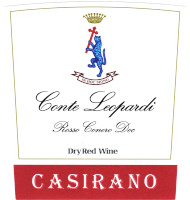
|
|
Rosso Conero Casirano 2014 |
|
| Conte Leopardi Dittajuti (Marches, Italy) | |
 Montepulciano Montepulciano | |
| Price: € 17.50 | Score: |
 Intense ruby red and nuances of garnet red, little transparency. Intense ruby red and nuances of garnet red, little transparency. Intense, clean, pleasing and refined, starts with hints of plum, black
cherry and dried violet followed by aromas of blueberry, blackberry,
chocolate, tobacco, mace and menthol. Intense, clean, pleasing and refined, starts with hints of plum, black
cherry and dried violet followed by aromas of blueberry, blackberry,
chocolate, tobacco, mace and menthol.
 Properly tannic attack and however balanced by alcohol, good body,
intense flavors, agreeable. Properly tannic attack and however balanced by alcohol, good body,
intense flavors, agreeable.
 Persistent finish with flavors of plum, black cherry and blueberry. Persistent finish with flavors of plum, black cherry and blueberry. 12 months in barrique, 10 months in bottle. 12 months in barrique, 10 months in bottle. |
|
 Broiled meat and barbecue, Roasted meat, Stewed meat with mushrooms, Hard cheese Broiled meat and barbecue, Roasted meat, Stewed meat with mushrooms, Hard cheese |
|
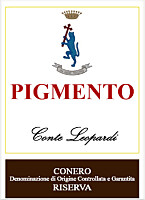
|
|
Conero Riserva Pigmento 2010 |
|
| Conte Leopardi Dittajuti (Marches, Italy) | |
 Montepulciano Montepulciano | |
| Price: € 26.00 | Score: |
 Deep ruby red and nuances of garnet red, little transparency. Deep ruby red and nuances of garnet red, little transparency. Intense, clean, pleasing, refined and elegant, starts with hints of
plum, blackberry and dried violet followed by aromas of black cherry jam,
blueberry, carob, tobacco, cocoa, cinnamon, mace, leather, licorice,
vanilla and menthol. Intense, clean, pleasing, refined and elegant, starts with hints of
plum, blackberry and dried violet followed by aromas of black cherry jam,
blueberry, carob, tobacco, cocoa, cinnamon, mace, leather, licorice,
vanilla and menthol.
 Properly tannic attack and however balanced by alcohol, full body,
intense flavors, agreeable. Properly tannic attack and however balanced by alcohol, full body,
intense flavors, agreeable.
 Persistent finish with flavors of plum, blackberry and blueberry. Persistent finish with flavors of plum, blackberry and blueberry. 22 months in barrique, 12 months in bottle. 22 months in barrique, 12 months in bottle. |
|
 Game, Roasted meat, Stewed and braised meat, Hard cheese Game, Roasted meat, Stewed and braised meat, Hard cheese |
|
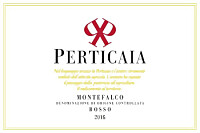
|
|
Montefalco Rosso 2016 |
|
| Perticaia (Umbria, Italy) | |
 Sangiovese (70%), Sagrantino (15%), Colorino (15%) Sangiovese (70%), Sagrantino (15%), Colorino (15%) | |
| Price: € 10.00 | Score: |
 Intense ruby red and nuances of garnet red, little transparency. Intense ruby red and nuances of garnet red, little transparency. Intense, clean, pleasing and refined, starts with hints of black
cherry, plum and violet followed by aromas of raspberry, blackberry,
blueberry, carob and orange. Intense, clean, pleasing and refined, starts with hints of black
cherry, plum and violet followed by aromas of raspberry, blackberry,
blueberry, carob and orange.
 Properly tannic attack and however balanced by alcohol, good body,
intense flavors, agreeable. Properly tannic attack and however balanced by alcohol, good body,
intense flavors, agreeable.
 Persistent finish with flavors of black cherry, plum and raspberry. Persistent finish with flavors of black cherry, plum and raspberry. 12 months in steel tanks, 6 months in bottle. 12 months in steel tanks, 6 months in bottle. |
|
 Cold cuts, Pasta with meat and mushrooms, Sauteed meat Cold cuts, Pasta with meat and mushrooms, Sauteed meat |
|
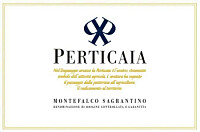
|
|
Montefalco Sagrantino 2015 |
|
| Perticaia (Umbria, Italy) | |
 Sagrantino Sagrantino | |
| Price: € 22.00 | Score: |
 Deep ruby red and nuances of garnet red, little transparency. Deep ruby red and nuances of garnet red, little transparency. Intense, clean, pleasing, refined and elegant, starts with hints of
blackberry, plum and black cherry followed by aromas of dried violet,
blueberry, tobacco, cocoa, juniper, cinnamon, leather, licorice,
undergrowth, vanilla and menthol. Intense, clean, pleasing, refined and elegant, starts with hints of
blackberry, plum and black cherry followed by aromas of dried violet,
blueberry, tobacco, cocoa, juniper, cinnamon, leather, licorice,
undergrowth, vanilla and menthol.
 Tannic attack and however balanced by alcohol, full body, intense
flavors, agreeable. Tannic attack and however balanced by alcohol, full body, intense
flavors, agreeable.
 Persistent finish with flavors of blackberry, plum and black cherry. Persistent finish with flavors of blackberry, plum and black cherry. 12 months in barrique, 12 months in steel tanks, 12 months in bottle. 12 months in barrique, 12 months in steel tanks, 12 months in bottle. |
|
 Game. Roasted meat, Stewed and braised meat, Hard cheese Game. Roasted meat, Stewed and braised meat, Hard cheese |
|
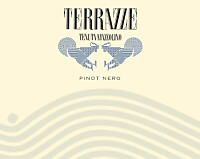
|
|
Terrazze 2019 |
|
| Tenuta Mazzolino (Lombardy, Italy) | |
 Pinot Nero Pinot Nero | |
| Price: € 13.00 | Score: |
 Brilliant ruby red and nuances of ruby red, moderate transparency. Brilliant ruby red and nuances of ruby red, moderate transparency. Intense, clean and pleasing, starts with hints of cherry, plum and
raspberry followed by aromas of strawberry, rose, pomegranate and cyclamen. Intense, clean and pleasing, starts with hints of cherry, plum and
raspberry followed by aromas of strawberry, rose, pomegranate and cyclamen.
 Properly tannic attack and however balanced by alcohol, good body,
intense flavors, pleasing crispness. Properly tannic attack and however balanced by alcohol, good body,
intense flavors, pleasing crispness.
 Persistent finish with flavors of cherry, raspberry and plum. Persistent finish with flavors of cherry, raspberry and plum. 5 months in steel tanks. 5 months in steel tanks. |
|
 Pasta with meat and mushrooms, Sauteed meat, Fish soups, Roasted white meat Pasta with meat and mushrooms, Sauteed meat, Fish soups, Roasted white meat |
|
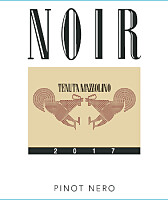
|
|
Oltrepo Pavese Pinot Nero Noir 2017 |
|
| Tenuta Mazzolino (Lombardy, Italy) | |
 Pinot Nero Pinot Nero | |
| Price: € 32.00 | Score: |
 Intense ruby red and nuances of garnet red, little transparency. Intense ruby red and nuances of garnet red, little transparency. Intense, clean, pleasing, refined and elegant, starts with hints of
cherry, plum and raspberry followed by aromas of dried rose, strawberry,
blueberry, chocolate, tobacco, leather, mace, pink pepper, vanilla and
menthol. Intense, clean, pleasing, refined and elegant, starts with hints of
cherry, plum and raspberry followed by aromas of dried rose, strawberry,
blueberry, chocolate, tobacco, leather, mace, pink pepper, vanilla and
menthol.
 Properly tannic attack and however balanced by alcohol, good body,
intense flavors, pleasing crispness. Properly tannic attack and however balanced by alcohol, good body,
intense flavors, pleasing crispness.
 Persistent finish with flavors of cherry, plum and raspberry. Persistent finish with flavors of cherry, plum and raspberry. 12 months in Burgundian pièce. 12 months in Burgundian pièce. |
|
 Roasted meat, Stewed and braised meat with mushrooms, Hard cheese Roasted meat, Stewed and braised meat with mushrooms, Hard cheese |
|
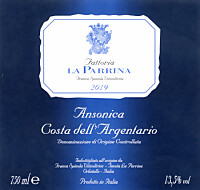
|
|
Ansonica Costa dell'Argentario 2019 |
|
| La Parrina (Tuscany, Italy) | |
 Ansonica Ansonica | |
| Price: € 9.90 | Score: |
 Brilliant straw yellow and nuances of greenish yellow, very transparent. Brilliant straw yellow and nuances of greenish yellow, very transparent. Intense, clean, pleasing and refined, starts with hints of apple, plum and
hazelnut followed by aromas of peach, citrus fruits, hawthorn, chamomile, pear
and lesser calamint. Intense, clean, pleasing and refined, starts with hints of apple, plum and
hazelnut followed by aromas of peach, citrus fruits, hawthorn, chamomile, pear
and lesser calamint.
 Crisp attack and however balanced by alcohol, good body, intense flavors,
agreeable. Crisp attack and however balanced by alcohol, good body, intense flavors,
agreeable.
 Persistent finish with flavors of apple, peach and plum. Persistent finish with flavors of apple, peach and plum. 6 months in steel tanks. 6 months in steel tanks. |
|
 Fried fish, Pasta and risotto wih fish and crustaceans, Vegetable soups, Sauteed fish Fried fish, Pasta and risotto wih fish and crustaceans, Vegetable soups, Sauteed fish |
|
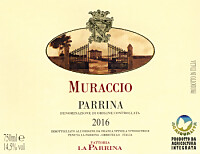
|
|
Parrina Rosso Muraccio 2016 |
|
| La Parrina (Tuscany, Italy) | |
 Sangiovese (80%), Cabernet Sauvignon (10%), Merlot (10%) Sangiovese (80%), Cabernet Sauvignon (10%), Merlot (10%) | |
| Price: € 11.90 | Score: |
 Intense ruby red and nuances of garnet red, little transparency. Intense ruby red and nuances of garnet red, little transparency. Intense, clean, pleasing and refined, starts with hints of black
cherry, plum and black currant followed by aromas of dried violet,
blueberry, geranium, pomegranate, carob, tobacco and vanilla. Intense, clean, pleasing and refined, starts with hints of black
cherry, plum and black currant followed by aromas of dried violet,
blueberry, geranium, pomegranate, carob, tobacco and vanilla.
 Properly tannic attack and however balanced by alcohol, good body,
intense flavors, agreeable. Properly tannic attack and however balanced by alcohol, good body,
intense flavors, agreeable.
 Persistent finish with flavors of black cherry, plum and black currant. Persistent finish with flavors of black cherry, plum and black currant. 3 years in cask and barrique. 3 years in cask and barrique. |
|
 Broiled meat and barbecue, Roasted meat, Stewed meat with mushrooms, Cheese Broiled meat and barbecue, Roasted meat, Stewed meat with mushrooms, Cheese |
|
News |
|
In this section are published news and information about events concerning the world of wine and food. Whoever is interested in publishing this kind of information can send us a mail to our address.
|
AquavitaeReview of Grappa, Distillates and Brandy |
|
|
||||||||||||
Wine Guide ParadeDecember 2020
|
| |||||||
Privacy Policy | |||||||


| Copyright © 2002-2024 Antonello Biancalana, DiWineTaste - All rights reserved |
| All rights reserved under international copyright conventions. No part of this publication and of this WEB site may be
reproduced or utilized in any form or by any means, electronic or mechanical, without permission in writing from DiWineTaste. |